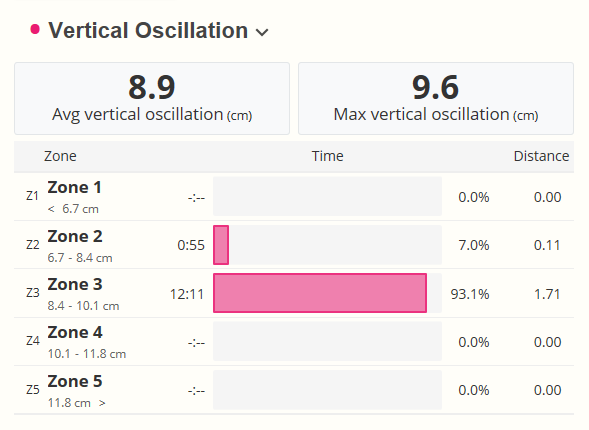You have to run fast, have a low vertical range, and keep your stride as unaffected as possible – running is a technical job!
Vertical amplitude, also called vertical oscillation (VO), refers to the height of the vertical movement of the body’s center of gravity during running.
When this amplitude is larger, it means that you are running less efficiently – more effort and time are spent moving your body up and down, and this behavior cannot directly be converted into forward force.
Generally speaking, the vertical amplitude of elite runners will be controlled to within 6cm, while that of ordinary runners is inferior, with an average of about 10cm.
The larger the vertical amplitude value, we can also see it with the naked eye during actual running:
Elite runners generally run as if their bodies are in a straight line, with their legs alternately touching the ground and just “translating” past; while every step of an average runner is more like an M-shaped movement, and it can be clearly seen that each step Every step feels like a “jump”.
This example is not appropriate but vivid enough: the vertical amplitude of the movement of the little penguin is very small, while the group of penguins below is jumping forward with every step, and the vertical amplitude is very exaggerated↓↓
Another point is that the higher the vertical amplitude, the greater the pressure (on the knees and joints) with each step, making it easier to get injured – this can also be understood as the reason why many people firmly believe that running hurts the knees but walking does not. .
Professional running watches can currently test various running data, such as stride frequency and vertical amplitude, and they display current data in real time. In other words, you can look at the watch from time to time to improve your running posture. , to improve in a better direction.
But there is also a misunderstanding here. In order to minimize data, many people often dare not take a step and turn into running in small steps at a reduced speed. This is also unnecessary.
It should be emphasized that the essence of all running data is to hope that you can reflect existing problems based on these data and make improvements to run better and faster. It is not to pursue making these data look as “excellent” as possible. , this is also a problem that many runners have after coming into contact with/understanding these data for the first time.
In addition, in order to achieve better results, some athletes will try their best to take longer steps/strides because they firmly believe that speed = step length * stride frequency. However, even though the stride length increases, the vertical amplitude data is often too high. It’s not very economical because every step takes a lot of effort to “push” the body into the air.
Ideally, the most perfect running/running form is to achieve a low vertical amplitude and a large stride length. There is a simple formula in running science, vertical amplitude ÷ stride length = vertical stride ratio (movement parameter). The lower the vertical stride ratio, the better your running technique is.
Note that vertical stride ratio has nothing to do with height.
Excellent runners often have a vertical stride ratio of <6.3%, while Olympic-level elite runners will have a vertical stride ratio of ≤3%! It means that they put all their efforts forward and reach an extremely high balance point economically.
Take the data of a certain runner as an example——
He ran a half marathon with an average vertical amplitude of 7.6cm;
It can be seen that the stride length is low at the beginning (probably during the warm-up period), and there is a long sprint at the end. The average stride length is 0.84 meters;
His vertical stride ratio averages 9%.
We can see that in the final stage of sprinting, the stride length becomes larger, while the vertical amplitude ratio basically does not change (or even decreases), which means that he does not push the ground when accelerating; while in the warm-up/starting stage, the data is not the same. Not ideal, I gradually entered the “cruising running” state at about 8-10 kilometers. If this is a race, spending more time warming up will also improve your efficiency in the first few kilometers.




